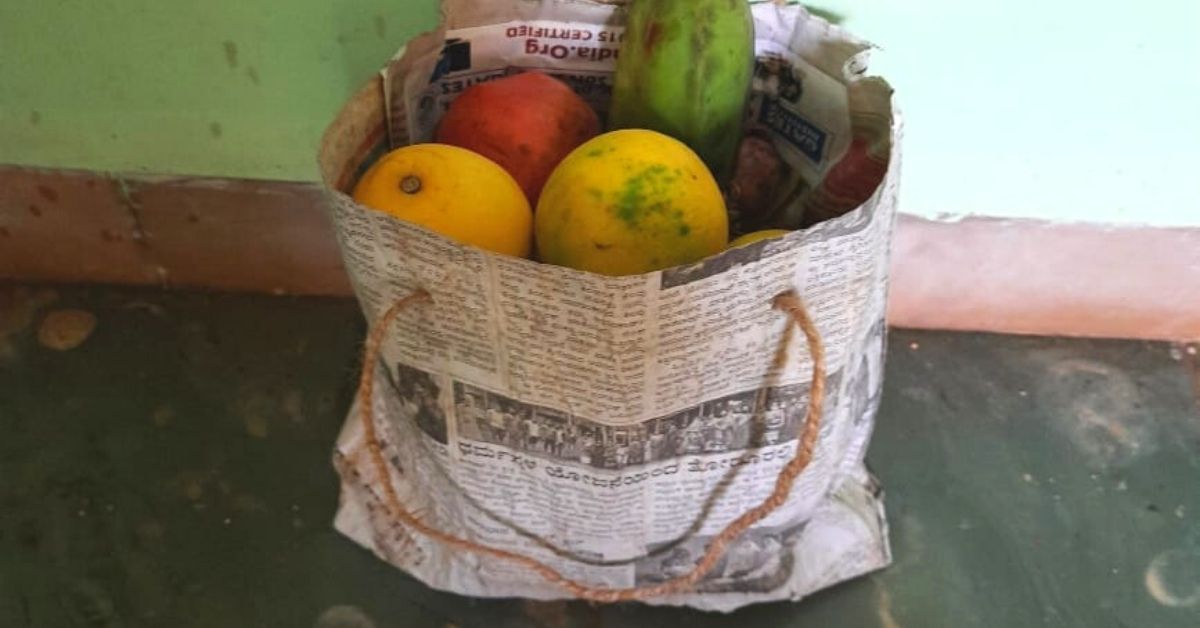While many of us are shifting from using plastic bags to carrying cloth or paper bags, these eco-friendly alternatives come with a drawback. They’re difficult to use when carrying fish, milk packets, and other damp items.
Dhananjay Hegde from Karwar in Karnataka also faced a similar problem.
“The state banned plastic bags in 2016, and many businesses opted for alternatives and even switched to using non-woven bags. But these bags are made from polypropylene and polyester, a form of plastic, and circulated in the market under the garb of being eco-friendly,” Dhananjay, a retired mechanical engineer, tells The Better India.
Dhananjay says that another peculiar issue he observed after the ban was that fish and meat sellers continued using plastic bags. “It is unfeasible to carry such food items in a paper or cloth bag, and there are no helpful alternatives. Moreover, paper bags cannot carry items weighing more than half a kilo,” he adds.
So Dhananjay has conceived bags made from newspaper using unique stitching techniques and corn powder that carry weight up to 10 kilos, do not leak, easily hold the meat and other damp items without clogging it. He has also built a machine to make the product commercially viable.
A bag with multiple benefits

Dhananjay says he wanted to make a bag that was strong and durable. “I decided to use scrap newspapers for the task and tried to reinforce a double sheet paper by adding stitches with the banana plant fibre. The material is eco-friendly and available locally,” he explains.
He adds that later, he decided to double the stitching inside the first at a gap of 1 cm. “The added strength allowed the bag to carry weight up to 5-10 kilos. But it could still not carry items with wet surfaces. When I tried, the paper clogged as it came in contact with liquid substances,” he says.
Dhananjay then decided to add a protective layer to the bag. “I researched for environment-friendly and natural materials and found that corn resin or gum could act as a layer to waterproof the paper bags,” he says.
He adds that he succeeded after a few experiments. “The gum prevented the water from coming in contact with the paper and held liquids without allowing any penetration in the layer,” he says.
To test his prototype, Dhananjay started carrying it to his office. “I used it almost daily, and many colleagues in the office inquired about it. I made some for them, and they used them to carry fish. Moreover, the bag costs Rs 2, as against Rs 5 or Rs 10 cloth bags in the market,” he says.
He added a layer of white paper to prevent toxic chemicals from newspapers from touching the corn starch layer and food.
To make the bags commercially viable, Dhananjay roped in his friend Dattatreya Bhatt to conceive a prototype device that can roll out multiple bags.

“We made the device using PVC pipes and pre-fabricated steel structures. The aim behind building a machine was to create dimensionally accurate and durable bags,” Dhananjay says, adding that he implemented the principles used in cloth weaving machines to blend with his unique pressing technique.
“A weaving machine can cost between Rs 15 and Rs 20 lakh, but our machine works on manual inputs producing ready paper for the bag for Rs 1.5 lakh. It can produce stitched paper rolls to make 300 small bags per day, but can vary depending on the user,” Dhananjay says, adding the rolled out stitched paper can easily fold into a bag.
He notes that 35 businesses have approached him to commercialise the bags. “I am ready to install the machine for free for commercial entities or people who wish to explore employment opportunities. I have identified an additional ten products that can be made similarly, including paper plates and other single-use items. We are working towards developing an improved model for the same,” he adds.
“I am glad that the innovation has worked and has the potential to generate employment and address the environmental crisis,” he says.
Edited by Divya Sethu
No comments:
Post a Comment